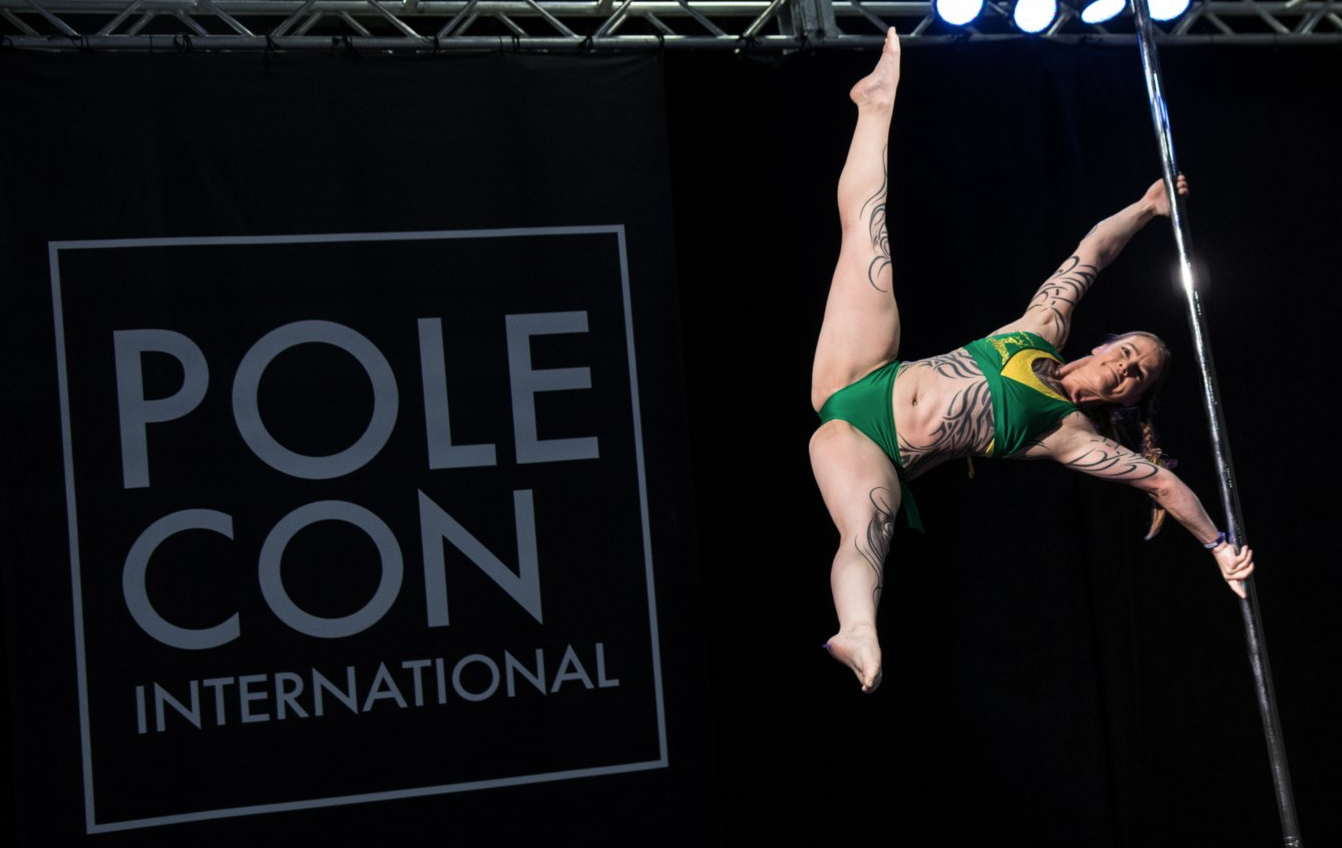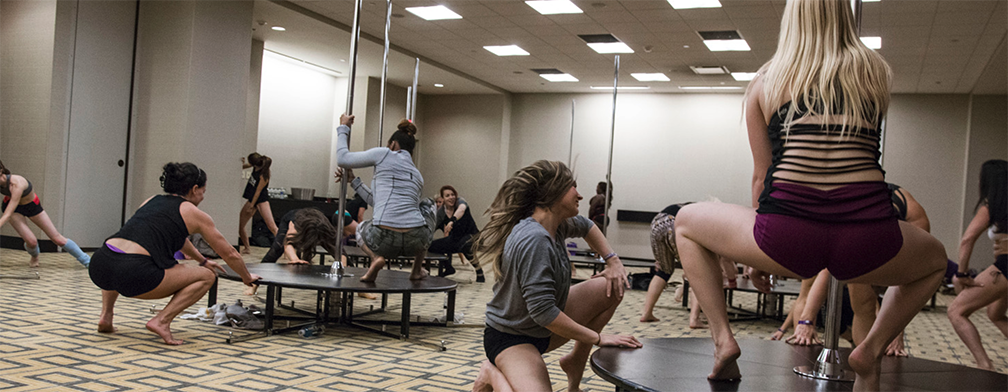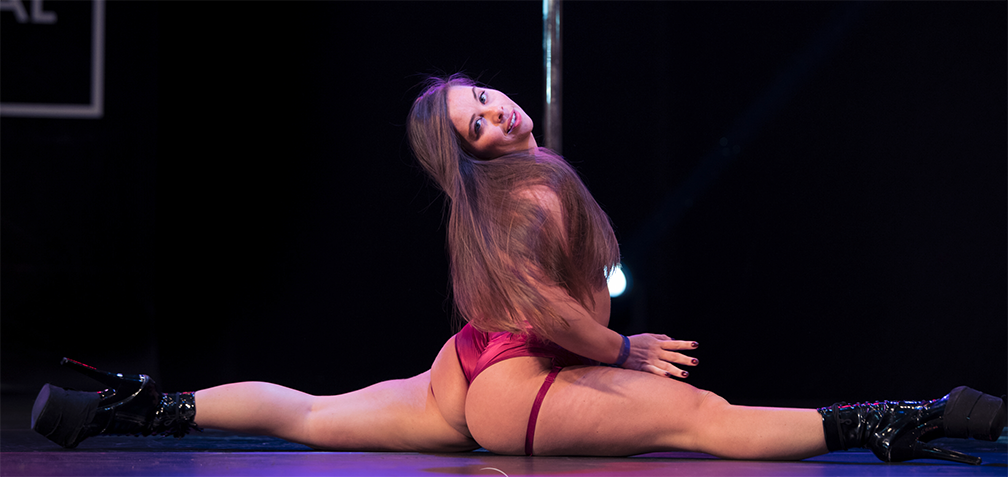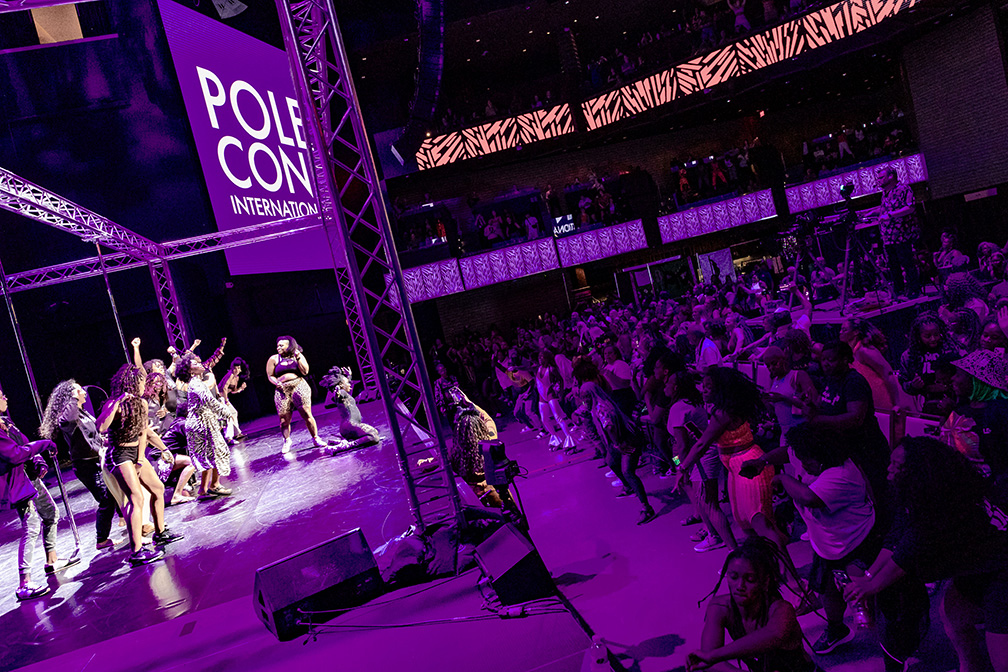Historically PoleCon has held workshops that were labeled: Beginner or All Levels Intermediate (basic climbing…

Do this ONE thing to improve your pole practice: breathe
Breathing is so natural to us as humans that we likely don’t even notice we’re doing it—or not doing it. The second we were born, we started to breath, letting out a wail to tell the world we have arrived.
Breathing is vital to life, bringing oxygen to our cells and releasing carbon dioxide so that our entire body functions. When we get angry or frustrated or are concentrating really hard, sometimes our natural breath stops. We hold our breath, or we breathe more shallowly. Pay attention the next time you’re in traffic. The more frustrated you are, the less likely you are to breathe. The more you hold your breath being frustrated, the more frustrated you become creating a cycle of stress reaction in your body. Your muscles might tense, and your heart rate might rise, you might grind your teeth, you might even blink less, as you become hyper alert. Even when you are out of that stressful situation, it may take time for your body to return to its normal resting state free of tension and breathing naturally.
There are many different physical movement practices that prescribe intentional breathing to improve physical functions. Additionally, our general well-being may be entirely dependent on learning to breath intentionally, particularly for stress and anxiety management to lower our heart rate and improve our blood pressure as we tackle scary or upsetting life events. We’ll look at a few different schools of thought on breathing and then bring those lessons into the pole studio for some practical tips.
Breathing as a Practice
Yoga has quite a lot to say about breathing and while every yoga class and school is different, the majority directs you to “focus on your breath” and may encourage some nose-only or mouth-only breathing with directions on how to breath from your “belly” (really your diaphragm) rather than from your throat (shallowly). Breathing is “automatic” to an extent, however just like the leg bone is connected to the ankle bone, it follows external and internal stimuli which means if you feel stressed or anxious even without traffic just sitting at your desk, your breath without intentional guidance may shorten and make you feel even more stressed creating a cycle of panic.
Intentionally breathing is also the foundation of the birthing practice Lamaze. Monitoring your intentional breath during a painful and potentially stressful activity like childbirth reduces anxiety and your heart rate keeping both momma and baby safer. Lamaze doesn’t need to be a specific “inhale through the nose, exhale through the mouth” practice or even involve the “heehee” noises you see popularized on TV, instead they recommend finding your natural rhythm as you intentionally shift your focus to your breathe during contractions.
The valsalva maneuver is a common weightlifters’ practice and is the intentional exhalation before you are about to lift something very heavy. It involves opening your mouth and breathing all your breath out as you lift. As soon as you breathe out all your air, you’ll need to breathe right back in and start the process again, particularly if you are doing repetitions of movement. Doing this maneuver not only improves blood pressure, it also tightens your abs a tiny bit, giving you an extra bit of intentional movement to your abs and that pressure very slightly protects the opposing muscles in your lower back which is critical not just in lifting yourself/heavy things but also in flexibility and contortion training.
Panic attacks as an extreme stress or anxiety reaction that can happen without warning can cause hyperventilation, the rapid over, or excessive breathing that changes the balance of carbon dioxide in your blood so that you have too much oxygen even though you feel like you don’t have enough and “can’t breathe.” Therapists recommend exercising as a way to “reset” your breathing during a panic attack or practicing intentional slow, deep breaths in your “belly” or even into a paper bag, which will help your breathing pattern stabilize and relieve the feelings of anxiety.
Breathing in the Studio
Let me know if this sounds familiar—you’re about to try a new move that maybe scares you a little bit (starting a stress reaction) and you screw up your face, think really hard, go to do the move aaannnnnd, can’t complete the move. You flop down, defeated. What happened? Sure, you might not be strong enough yet or have the right technique or flexibility, but likely it is because you stopped breathing.
As a pole student, it is hard to understand how breathing works at first as you concentrate so hard on executing the new movement and generally “not dying.” As a pole teacher, watching hundreds of different people try out moves that are now familiar, especially that either can scare them or cause a large muscle contraction like inverting or executing a fan kick, it is very easy to see that most students start their pole journeys holding their breath.
One of my pole colleagues and Black Girls Pole Ambassador, Zippora Lewis, not only tells her students to breathe but also to “open their mouths.” Breathing feels hard or complicated to do especially when you’re trying a move that involves all your concentration. Until your body is trained to exhale during big contractions, we often push our lips together and hold our breath; so opening our mouths becomes a good first step to intentionally breathing. She also recommends chewing gum while training. Most of us have been chewing gum way longer than we have been inverting so the chewing movement while breathing is a more established muscle memory. While I’m afraid of accidentally choking on my gum (particularly on spin pole), it is another good option to training your breath without thinking about training your breath.
I tell my students to breathe in general and particularly regarding exhalation during certain contracting movements and tap them gently to reinforce my words (particularly useful when upside down—“Angie breathe! <tap>”). If it is too hard to breathe, I tell them to sing, hum (I prefer “I’m a Little Teapot”) or talk to yourself while you’re doing a move. As a teacher, I’m talking all the time during class—“And you grab with your right while tucking your tailbone and extending through the wrist”—which forces me to breathe and makes all my moves much easier to demonstrate. When I am training by myself or taking a class, I still have trouble breathing so I wind up “teaching” the new move I’m trying to master verbally to myself or trying some positive self talk: “You got this, you just did this yesterday, it’s just a flip, just a flip. You’re strong, right arm higher than the left annnnnddd GO” so that I keep my mouth and my breath moving.
Some movements are more beneficial to do while you inhale while others while you exhale. Typically during any big contraction movement you should exhale while any time you are extending, inhale. Until you find this rhythm with your own pole practice (which involves lots of contraction and extension of different parts all at the same time), do ANYTHING to keep your mouth open and your breath moving including singing, chewing gum and talking to yourself. Police yourself, your friends and even your teacher because sometimes we all forget to breathe. Intentionally learning how to breathe has helped my pole practice IMMENSELY and has had the benefit of also helping me stress less in traffic (“deep breaths, he’s just an a-hole, deep breaths, hope you get a flat tire”). Try being intentional in your breath next time you’re in the studio and see how it immediately improves your pole practice (or try inverting while intentionally holding your breath—NOT fun).
And when all else fails OPEN YOUR MOUTH! (Thanks Z!)
Latest posts by Colleen (see all)
- Updating Workshop Levels at PoleCon (2025 and Beyond) - July 19, 2024
- PoleCon Exhibitor Spotlight: Flaaluhs - July 5, 2024
- Teacher Tip: How to improve your verbal cues - June 28, 2024


